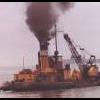-
Posts
5,118 -
Joined
-
Last visited
Reputation Activity
-
 RGL got a reaction from popeye the sailor in VARYAG by RGL -FINISHED - Artwox - 1/350 - Plastic, resin and photoetch - Protected Cruiser
RGL got a reaction from popeye the sailor in VARYAG by RGL -FINISHED - Artwox - 1/350 - Plastic, resin and photoetch - Protected Cruiser
Now to the Davits. They are a layer cake construction making them thicker. They have tiny little brackets to attach them to the hull. The rigging was replaced once I constructed them with Ezyline. Some bits are still hanging loose which i will place rope coils at the ends. There are two resin ones as well which sit behind the bridge. All 4 of them were broken on the resin fret when I opened the box and had to be repaired.
-
 RGL got a reaction from popeye the sailor in VARYAG by RGL -FINISHED - Artwox - 1/350 - Plastic, resin and photoetch - Protected Cruiser
RGL got a reaction from popeye the sailor in VARYAG by RGL -FINISHED - Artwox - 1/350 - Plastic, resin and photoetch - Protected Cruiser
Ok, the last of the railings are complete. Given it is soo tiny, it just takes ages to thread these needles.
-
 RGL got a reaction from hexnut in VARYAG by RGL -FINISHED - Artwox - 1/350 - Plastic, resin and photoetch - Protected Cruiser
RGL got a reaction from hexnut in VARYAG by RGL -FINISHED - Artwox - 1/350 - Plastic, resin and photoetch - Protected Cruiser
Now to the Davits. They are a layer cake construction making them thicker. They have tiny little brackets to attach them to the hull. The rigging was replaced once I constructed them with Ezyline. Some bits are still hanging loose which i will place rope coils at the ends. There are two resin ones as well which sit behind the bridge. All 4 of them were broken on the resin fret when I opened the box and had to be repaired.
-
 RGL got a reaction from hexnut in VARYAG by RGL -FINISHED - Artwox - 1/350 - Plastic, resin and photoetch - Protected Cruiser
RGL got a reaction from hexnut in VARYAG by RGL -FINISHED - Artwox - 1/350 - Plastic, resin and photoetch - Protected Cruiser
Ok, the last of the railings are complete. Given it is soo tiny, it just takes ages to thread these needles.
-
 RGL got a reaction from coxswain in VARYAG by RGL -FINISHED - Artwox - 1/350 - Plastic, resin and photoetch - Protected Cruiser
RGL got a reaction from coxswain in VARYAG by RGL -FINISHED - Artwox - 1/350 - Plastic, resin and photoetch - Protected Cruiser
Now to the Davits. They are a layer cake construction making them thicker. They have tiny little brackets to attach them to the hull. The rigging was replaced once I constructed them with Ezyline. Some bits are still hanging loose which i will place rope coils at the ends. There are two resin ones as well which sit behind the bridge. All 4 of them were broken on the resin fret when I opened the box and had to be repaired.
-
 RGL got a reaction from coxswain in VARYAG by RGL -FINISHED - Artwox - 1/350 - Plastic, resin and photoetch - Protected Cruiser
RGL got a reaction from coxswain in VARYAG by RGL -FINISHED - Artwox - 1/350 - Plastic, resin and photoetch - Protected Cruiser
Ok, the last of the railings are complete. Given it is soo tiny, it just takes ages to thread these needles.
-
 RGL got a reaction from Canute in HMS Dreadnought by clearway - Zvezda - 1/350 scale - PLASTIC - with upgrades
RGL got a reaction from Canute in HMS Dreadnought by clearway - Zvezda - 1/350 scale - PLASTIC - with upgrades
Nice work, this upgrade kit is definitely in the cue for me
-
 RGL got a reaction from BANYAN in VARYAG by RGL -FINISHED - Artwox - 1/350 - Plastic, resin and photoetch - Protected Cruiser
RGL got a reaction from BANYAN in VARYAG by RGL -FINISHED - Artwox - 1/350 - Plastic, resin and photoetch - Protected Cruiser
Now to the Davits. They are a layer cake construction making them thicker. They have tiny little brackets to attach them to the hull. The rigging was replaced once I constructed them with Ezyline. Some bits are still hanging loose which i will place rope coils at the ends. There are two resin ones as well which sit behind the bridge. All 4 of them were broken on the resin fret when I opened the box and had to be repaired.
-
 RGL got a reaction from BANYAN in VARYAG by RGL -FINISHED - Artwox - 1/350 - Plastic, resin and photoetch - Protected Cruiser
RGL got a reaction from BANYAN in VARYAG by RGL -FINISHED - Artwox - 1/350 - Plastic, resin and photoetch - Protected Cruiser
Ok, the last of the railings are complete. Given it is soo tiny, it just takes ages to thread these needles.
-
 RGL got a reaction from mtaylor in VARYAG by RGL -FINISHED - Artwox - 1/350 - Plastic, resin and photoetch - Protected Cruiser
RGL got a reaction from mtaylor in VARYAG by RGL -FINISHED - Artwox - 1/350 - Plastic, resin and photoetch - Protected Cruiser
Ok, the last of the railings are complete. Given it is soo tiny, it just takes ages to thread these needles.
-
 RGL reacted to DaveRow in HMB Endeavour by DaveRow - FINISHED - Corel - Scale 1:60 - First Build Kit
RGL reacted to DaveRow in HMB Endeavour by DaveRow - FINISHED - Corel - Scale 1:60 - First Build Kit
Some progress on the Windlass.
I turned up the barrel on my home made lathe.
The Bit pins & cheeks(ends) come apart to house the barrel, the cheek bottom held in with a brass bracket, the top with a brass bolt. Took a while to finely tuned the fitting to get the barrel to turn.
I was surprised the figure heads came up fairly well I reckon.
Only 2 days work. !
Next to add the pin rail, whelps, brackets etc. make the bell tower thingy. Mine will be something based on the replica, 2 posts.
PS. I have yet to trim the ends of the barrel off, left them on for now.
Dave R
-
 RGL got a reaction from Ryland Craze in HMB Endeavour by RGL -FINISHED - Artesania Latina
RGL got a reaction from Ryland Craze in HMB Endeavour by RGL -FINISHED - Artesania Latina
Job complete. Very little of the AL kit was used, and as I said to my 10 year old last night, I started this when you were a baby, it's now in this glass box and you can do whatever you want with it after I'm dead, as it's not going anywhere.
-
 RGL got a reaction from maggsl_01 in HMB Endeavour by RGL -FINISHED - Artesania Latina
RGL got a reaction from maggsl_01 in HMB Endeavour by RGL -FINISHED - Artesania Latina
I have re varnished the base and attached the pedestals. I also use some brass rods to act as support struts to hopefully keep the ship from future cat tipping
-
 RGL got a reaction from clearway in HMS Dreadnought by clearway - Zvezda - 1/350 scale - PLASTIC - with upgrades
RGL got a reaction from clearway in HMS Dreadnought by clearway - Zvezda - 1/350 scale - PLASTIC - with upgrades
Nice work, this upgrade kit is definitely in the cue for me
-
 RGL reacted to clearway in HMS Dreadnought by clearway - Zvezda - 1/350 scale - PLASTIC - with upgrades
RGL reacted to clearway in HMS Dreadnought by clearway - Zvezda - 1/350 scale - PLASTIC - with upgrades
This has been on my wish list for a couple of years now! Using master gun barrells and the Eduard upgrade which although designed for the trumpeter version is usable with the zvezda one. Heres progress so far.
Basic hull went together very well- note the moulded line for if you wish to model her as waterline version.
Deck is painted with Humbrol satin oak thinned down. Care is needed as the deck planking is very finely moulded.
Master gun barrells and eduard turret overlays in place- those gun barrells sure look nice- pity they will be painted.
Keith
-
 RGL reacted to wefalck in SMS WESPE 1876 by wefalck – 1/160 scale - Armored Gunboat of the Imperial German Navy - as first commissioned
RGL reacted to wefalck in SMS WESPE 1876 by wefalck – 1/160 scale - Armored Gunboat of the Imperial German Navy - as first commissioned
S.M.S. WESPE (HENK, 1895)
History and context
The WESPE-Class armoured gun-boats of the then young Imperial German Navy were born out of a tactical concept that dated well back into the Napoleonic era. The idea was to mount a heavy long-range gun onto a highly mobile small craft that would be able to retire into shallow coastal waters, beyond the range of even the heavy artillery of an attacking fleet. The addition of a steam engine and the increase in calibre followed the development of the time, of course. Adding heavy armour to the front (mainly) was meant to give the gun-boats a certain attacking capability. It also owes something to the floating batteries used in the defence of Copenhagen during the Napoleonic wars and to the armoured floating batteries used by the allied French/British forces during the Crimean War (1854-55). In fact, adding armour plating to a (rowing) gunboat was already proposed as early as the late 18th century in Spain, as documented by a model in the Museo Naval in Madrid, but apparently never put to work in full scale.
S.M.S. WESPE, brand-new and still without the 30.5 cm gun (1875)
At the time of the conception of the WESPE-class in the early 1870s a former cavalry(!) general was the naval chief-of-staff in Germany. The tactical dogma was ‘proactive defence’: an attacking enemy was to be awaited near home waters and fenced off. The main threat was seen in amphibian operations attacking the German coast. Thus, the landing of troops at strategic points had to be prevented. Long-range strategic and oceanic operations were out of the scope of the German naval planners of the time. There was a certain logic in this, as Germany, unlike Britain, is/was a more or less land-locked country and largely self-sufficient in many respects at that time. Overseas trade then did not have such an importance as in Britain or as in later globalising economies. Therefore, attempts to severe overseas supply chains was not so relevant. There was, indeed, active resistance from trade interest groups, particularly the merchants in the cities of Hamburg and Bremen, to a navy that would engage itself overseas. These merchants relied on their network of friendly contacts and on sailing under a neutral flag.
Hence, the WESPE-Class was designed to be mainly a heavily armoured gun-platform, giving long-range protection to the tidal North Sea harbours that are surrounded by mud-flats and to give mobile protection to the deep fjords of Schleswig-Holstein's Baltic coast. They would be backed-up by heavy artillery (and later fixed torpedo batteries) in coastal forts.
The guns in such boats usually could only be trained by turning the whole boat. This seems more difficult then it probably was, because even in the old days of the rowing gunboats they would attack by rowing in a wide circle and when the intended target passed through the line of aim, one would fire. As the WESPE-Class was designed to let themselves fall dry on mud-flats, a possibility to train the gun itself was needed.
This distinguished the WESPE-class from earlier boats of similar design in Britain, namely the ANT-, GADFLY-, and BOUNCER-class of the 1860s. Man other navies took up the same concept and there were examples in the Danish, Dutch, French, Norwegian, Spanish, and even the Argentinian navy. Some of the were armoured, while other were still constructed from wood or composite.
S.M.S. WESPE under construction (HENK, 1895)
Technical Description
The WESPE-class comprised ten boats delivered in two batches between 1876 and 1880: WESPE (1876), VIPER, BIENE, MÜCKE, SCORPION, BASILISK, CAMAELEON, CROCODILL, SALAMANDER and NATTER. They were all built by A.G. Weser in Bremen. With a length of 46.4 m and a beam of 10.65 m they had a dead weight of 1157 t, drawing 3.37 m. The dimensions vary somewhat according to source, but this may be due to different reference points, such as length overall compared to length between the perpendicles etc.
Two inclined double-expansion engines on two propellers gave a maximum speed of 11 knots. Their original complement was 3 officers and 73 crew. Steering was from a stand on the hut and an emergency double steering wheel abaft. Very early on they were also retrofitted with an electrical generator.
The WESPE-class were the first German warships (and indeed among the first of any warship) that did completely without auxiliary sails. As the consequence they only had a light mast for signalling. In spite of sporting quite some leading edge technology, they were only of limited seaworthiness and their handling was far from perfect. This resulted in them being given a collection of rather unfavourable nicknames. They were also not very popular with their crews and officers due to the cramped conditions below decks, but then they were not meant for long voyages in the open sea.
Admiralty illustrative drawing (before 1883)
Armament
The main armament was a single 30.5 cm rifled breech-loading gun designed and manufactured by Alfred Krupp AG in Essen. At the time the WESPE-class boats were designed, fast torpedo-boats did not exist yet – the automotive fish-torpedo was just being developed. When in the mid-1880s small torpedo-boats became a tactical reality, some form of self-defence against them was necessary and two bronce(!) 8.7 cm/l24 breech-loading guns in ‘disappearing’ carriage and two 37 mm Hotchkiss revolving guns came on board. In fact, very early on (1883) also two 35 cm underwater torpedo launching tubes were installed to increase the attacking capabilities.
Instruction model for the Rk 30.5/l22 on the Danish HELGOLAND in the Orlogsmuseet Copenhagen on a carriage similar to that of the WESPE-Class
Scale
The scale chosen for the model is 1/160, which admittedly is somewhat unusual for a ship model. However, the reasoning behind this choice was that a large selection of N-scale railway figures is available that eventually will crew the ship. There are also space and portability consideration, which are important for someone, who has to move from time to time for professional reasons.
The model will be a waterline model. This will allow a scenic presentation of the finished model. Besides, the hull below the waterline is not quite so graceful. Above the waterline the hull is also more or less prismatic, with vertical bulwarks and virtually no sheer. These parameters together call for a bread-and-butter construction.
Artist’s impression of a WESPE-Class gunboat (1891)
Sources
Owing to the loss of most of the archival material from the former Admiralty Drawing Office during and after the end of WW2, detailed source material is rather scant. Some lithographed drawings that must have been made before the major refit in 1883 have survived and serve as a basis for the reconstruction. The Bundesarchiv/Militärarchiv in Freiburg i.B. has some drawings, but unfortunatelly they only pertain to a much later refit of S.M.S. NATTER. However, the WESPE-Class was a bit of a novelty at its time and some Detaildrawings of bothm the ship and the armament, have found their way into textbooks of the time. Relatively recently a very detailed original drawing of the gun became available on the Internet from a private collection (www.dreadnoughtproject.org). Historic photographs from the early days of the ships are quite rare and mostly of not so good quality, but some reasonably good ones from the end of their active life have survived.
Based on the information that was available in the 1980s Wolfgang Bohlayer drew and published a plan of S.M.S. WESPE as she might have looked like after the major refit in 1883 (available from VTH, http://shop.vth.de/wespe-1876.html). Based on the information available today, this plan would need to be revised in some details.
The available information is summarised on the page on the WESPE-class on my Web-site: http://www.wefalck.eu/mm/maritime/models/wespe/wespeclass.html
To be continued ...
-
 RGL reacted to Snoepert in HMB Endeavour by RGL -FINISHED - Artesania Latina
RGL reacted to Snoepert in HMB Endeavour by RGL -FINISHED - Artesania Latina
Greg,
I wish to express my thanks to all your amazing collection of invaluable photos.
They have given me such inspiration to improve on my work as this is my first attempt to build a wooden ship.
I am currently working on the rigging and seeing your work gives a great guide on how to install.
Thanks again,
Eddie (snoepert)
-
 RGL reacted to GuntherMT in Armed Virginia Sloop by GuntherMT - FINISHED - Model Shipways - scale 1:48
RGL reacted to GuntherMT in Armed Virginia Sloop by GuntherMT - FINISHED - Model Shipways - scale 1:48
Sneak peak on the finish line approaching.. I've been working on a display base to hold the ship at the slight angle it should be at to make the waterline 'level' with the viewer, and finally started working on the anchor buoys and I rigged the catheads.
What could this possibly be?
Silliness is what it is!
And that sneak peak...
-
 RGL got a reaction from Burroak in HMB Endeavour by Captain Slog - Caldercraft - 1:64
RGL got a reaction from Burroak in HMB Endeavour by Captain Slog - Caldercraft - 1:64
Um, not sure what you mean, but this is how I did mine,
-
 RGL got a reaction from rvchima in HMB Endeavour by Captain Slog - Caldercraft - 1:64
RGL got a reaction from rvchima in HMB Endeavour by Captain Slog - Caldercraft - 1:64
Nice and square, but I'd do all the rope work and blocks before you stick it on for good
-
 RGL got a reaction from popeye the sailor in VARYAG by RGL -FINISHED - Artwox - 1/350 - Plastic, resin and photoetch - Protected Cruiser
RGL got a reaction from popeye the sailor in VARYAG by RGL -FINISHED - Artwox - 1/350 - Plastic, resin and photoetch - Protected Cruiser
Slow plod, I have added the stanchions for the stern, bow and amidships. They come with a 0.1mm copper wire which does not blacken well and does not run as well as a 0.01mm rigging line. My eyes hurt this is so small now. 2 hours to do the bow. To the naked eye it looks great compared to the etch railing.
-
 RGL got a reaction from hexnut in VARYAG by RGL -FINISHED - Artwox - 1/350 - Plastic, resin and photoetch - Protected Cruiser
RGL got a reaction from hexnut in VARYAG by RGL -FINISHED - Artwox - 1/350 - Plastic, resin and photoetch - Protected Cruiser
Slow plod, I have added the stanchions for the stern, bow and amidships. They come with a 0.1mm copper wire which does not blacken well and does not run as well as a 0.01mm rigging line. My eyes hurt this is so small now. 2 hours to do the bow. To the naked eye it looks great compared to the etch railing.
-
 RGL got a reaction from coxswain in VARYAG by RGL -FINISHED - Artwox - 1/350 - Plastic, resin and photoetch - Protected Cruiser
RGL got a reaction from coxswain in VARYAG by RGL -FINISHED - Artwox - 1/350 - Plastic, resin and photoetch - Protected Cruiser
Slow plod, I have added the stanchions for the stern, bow and amidships. They come with a 0.1mm copper wire which does not blacken well and does not run as well as a 0.01mm rigging line. My eyes hurt this is so small now. 2 hours to do the bow. To the naked eye it looks great compared to the etch railing.
-
 RGL got a reaction from Old Collingwood in VARYAG by RGL -FINISHED - Artwox - 1/350 - Plastic, resin and photoetch - Protected Cruiser
RGL got a reaction from Old Collingwood in VARYAG by RGL -FINISHED - Artwox - 1/350 - Plastic, resin and photoetch - Protected Cruiser
Slow plod, I have added the stanchions for the stern, bow and amidships. They come with a 0.1mm copper wire which does not blacken well and does not run as well as a 0.01mm rigging line. My eyes hurt this is so small now. 2 hours to do the bow. To the naked eye it looks great compared to the etch railing.
-
 RGL got a reaction from ccoyle in VARYAG by RGL -FINISHED - Artwox - 1/350 - Plastic, resin and photoetch - Protected Cruiser
RGL got a reaction from ccoyle in VARYAG by RGL -FINISHED - Artwox - 1/350 - Plastic, resin and photoetch - Protected Cruiser
Slow plod, I have added the stanchions for the stern, bow and amidships. They come with a 0.1mm copper wire which does not blacken well and does not run as well as a 0.01mm rigging line. My eyes hurt this is so small now. 2 hours to do the bow. To the naked eye it looks great compared to the etch railing.















